Do you have a question about the Yamaha V star 1100 and is the answer not in the manual?
Emphasizes areas where injury or death could result from negligence. Mechanical damage may occur.
Do not operate in enclosed areas; ensure proper ventilation. Avoid flammable liquids.
Wear eye protection, correct clothing, tie up long hair. Do not carry sharp tools in pockets.
Do not inhale brake pad dust; it may contain asbestos, hazardous to health.
Gasoline is volatile, flammable, and hazardous. Vapor is heavier than air and easily ignited.
Work in well-ventilated areas, wear safety glasses, avoid sparks and flames.
Do not add fuel near open flames or smokers. Allow engine to cool before working on fuel system.
Do not pour water on gasoline fires. Use Class B, BC, or ABC extinguisher.
Turn off engine before refueling. Do not overfill tank. Leave air space for expansion.
Use a torque wrench for correct tightness. Specifications vary by component.
Precision tools for accurate tightening. Adapters change effective lever length.
Feeler gauges, calipers, micrometers, etc. Ensure proper care and use for accurate results.
Hydraulic fluid for brakes. Use only DOT 4; do not intermix types.
Check oil level through sight glass in alternator cover. Ensure correct level.
Follow recommended intervals. Use SE, SF, or SG API classification oil.
Inspect valve seats for wear or damage. Recondition or replace as needed.
Procedures for removal, installation, inspection, and clearance checks.
Service procedures for clutch plates, discs, springs, and related components.
Procedure for measuring and adjusting middle gear backlash.
Operation, removal, installation, cleaning, inspection, and assembly.
Removal, installation, operational test, resistance test, and relay test.
Service procedures for electrical sub-systems and components.
Components, troubleshooting, current draw test, and charging voltage test.
Components, troubleshooting, spark plug cap and ignition coil resistance tests.
Components, troubleshooting, starter operational test, disassembly, assembly, and inspection.
Repair and maintenance procedures for wheels, tires, and related components.
Inspection of seals, bearings, runout, and brake disc condition.
Procedure for balancing wheels, including static and dynamic methods.
Service procedures for handlebars, front forks, and steering components.
Procedures for fork leg removal, disassembly, installation, and inspection.
Removal, installation, and inspection of the steering head components.
Service procedures for rear shock absorber, swing arm, drive shaft, and final drive.
Removal, installation, inspection, gear lash measurement, and shim selection.
Service procedures for front and rear brake systems.
Precautions to prevent damage from brake fluid spills.
Procedures for bleeding air from the brake system (manual and vacuum).
Inspection and replacement procedures for front and rear brake pads.
Emphasizes areas where injury or death could result from negligence. Mechanical damage may occur.
Do not operate in enclosed areas; ensure proper ventilation. Avoid flammable liquids.
Wear eye protection, correct clothing, tie up long hair. Do not carry sharp tools in pockets.
Do not inhale brake pad dust; it may contain asbestos, hazardous to health.
Gasoline is volatile, flammable, and hazardous. Vapor is heavier than air and easily ignited.
Work in well-ventilated areas, wear safety glasses, avoid sparks and flames.
Do not add fuel near open flames or smokers. Allow engine to cool before working on fuel system.
Do not pour water on gasoline fires. Use Class B, BC, or ABC extinguisher.
Turn off engine before refueling. Do not overfill tank. Leave air space for expansion.
Use a torque wrench for correct tightness. Specifications vary by component.
Precision tools for accurate tightening. Adapters change effective lever length.
Feeler gauges, calipers, micrometers, etc. Ensure proper care and use for accurate results.
Hydraulic fluid for brakes. Use only DOT 4; do not intermix types.
Check oil level through sight glass in alternator cover. Ensure correct level.
Follow recommended intervals. Use SE, SF, or SG API classification oil.
Inspect valve seats for wear or damage. Recondition or replace as needed.
Procedures for removal, installation, inspection, and clearance checks.
Service procedures for clutch plates, discs, springs, and related components.
Procedure for measuring and adjusting middle gear backlash.
Operation, removal, installation, cleaning, inspection, and assembly.
Removal, installation, operational test, resistance test, and relay test.
Service procedures for electrical sub-systems and components.
Components, troubleshooting, current draw test, and charging voltage test.
Components, troubleshooting, spark plug cap and ignition coil resistance tests.
Components, troubleshooting, starter operational test, disassembly, assembly, and inspection.
Repair and maintenance procedures for wheels, tires, and related components.
Inspection of seals, bearings, runout, and brake disc condition.
Procedure for balancing wheels, including static and dynamic methods.
Service procedures for handlebars, front forks, and steering components.
Procedures for fork leg removal, disassembly, installation, and inspection.
Removal, installation, and inspection of the steering head components.
Service procedures for rear shock absorber, swing arm, drive shaft, and final drive.
Removal, installation, inspection, gear lash measurement, and shim selection.
Service procedures for front and rear brake systems.
Precautions to prevent damage from brake fluid spills.
Procedures for bleeding air from the brake system (manual and vacuum).
Inspection and replacement procedures for front and rear brake pads.
| Displacement | 1063cc |
|---|---|
| Bore x Stroke | 95.0mm x 75.0mm |
| Compression Ratio | 8.3:1 |
| Ignition | TCI |
| Transmission | 5-speed |
| Final Drive | Shaft |
| Front Suspension | Telescopic fork |
| Front Brakes | Dual disc |
| Front Tire | 130/90-16 |
| Rear Tire | 170/80-15 |
| Engine Type | Air-cooled, SOHC, V-twin |
| Fuel Capacity | 4.5 gallons |
| Rear Brakes | Single disc |
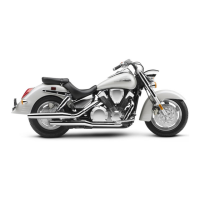
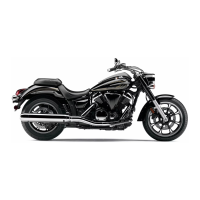
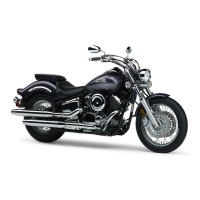
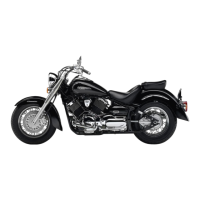

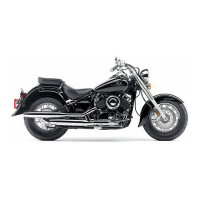
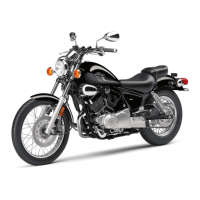
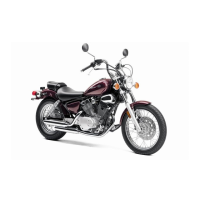
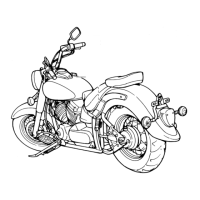
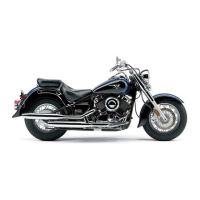
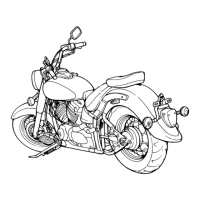

